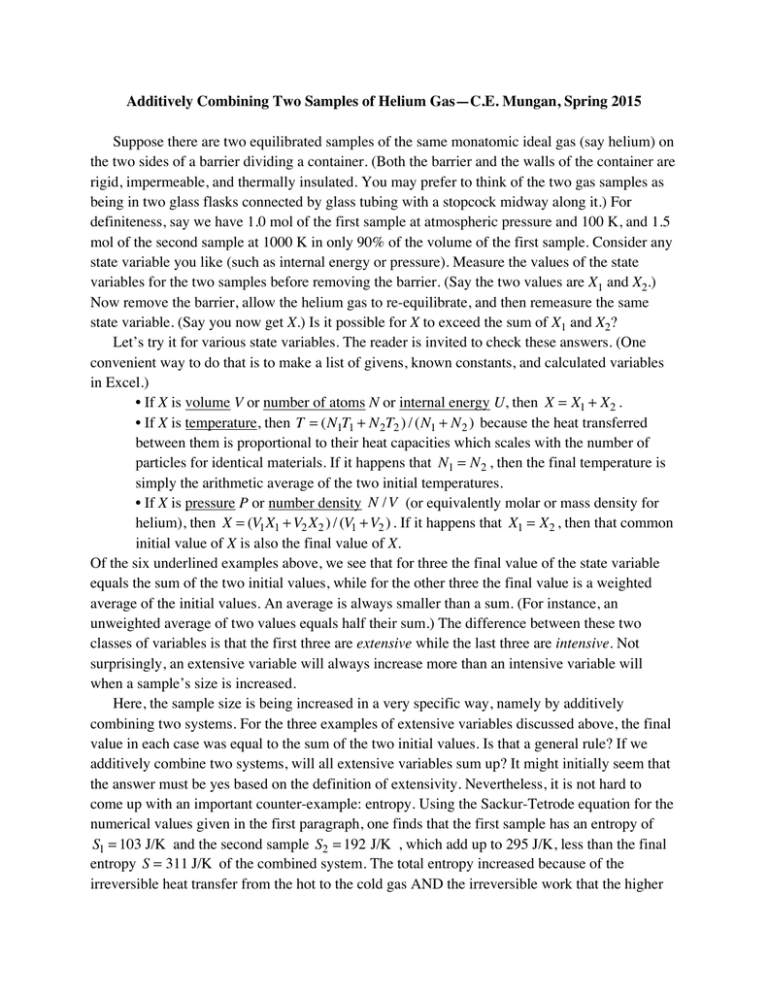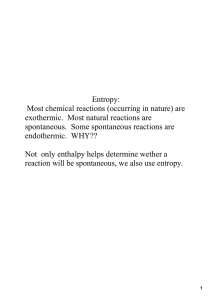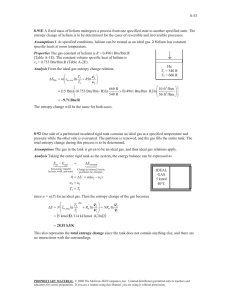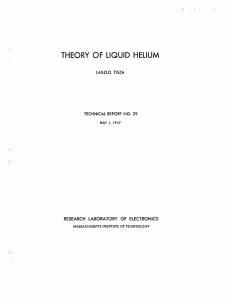Additively Combining Two Samples of Helium Gas—C.E. Mungan, Spring 2015
advertisement

Additively Combining Two Samples of Helium Gas—C.E. Mungan, Spring 2015 Suppose there are two equilibrated samples of the same monatomic ideal gas (say helium) on the two sides of a barrier dividing a container. (Both the barrier and the walls of the container are rigid, impermeable, and thermally insulated. You may prefer to think of the two gas samples as being in two glass flasks connected by glass tubing with a stopcock midway along it.) For definiteness, say we have 1.0 mol of the first sample at atmospheric pressure and 100 K, and 1.5 mol of the second sample at 1000 K in only 90% of the volume of the first sample. Consider any state variable you like (such as internal energy or pressure). Measure the values of the state variables for the two samples before removing the barrier. (Say the two values are X1 and X2.) Now remove the barrier, allow the helium gas to re-equilibrate, and then remeasure the same state variable. (Say you now get X.) Is it possible for X to exceed the sum of X1 and X2? Let’s try it for various state variables. The reader is invited to check these answers. (One convenient way to do that is to make a list of givens, known constants, and calculated variables in Excel.) • If X is volume V or number of atoms N or internal energy U, then X = X1 + X2 . • If X is temperature, then T = (N1T1 + N 2T2 ) / (N1 + N 2 ) because the heat transferred between them is proportional to their heat capacities which scales with the number of particles for identical materials. If it happens that N1 = N 2 , then the final temperature is simply the arithmetic average of the two initial temperatures. • If X is pressure P or number density N / V (or equivalently molar or mass density for helium), then X = (V1 X1 + V2 X2 ) / (V1 + V2 ) . If it happens that X1 = X2 , then that common initial value of X is also the final value of X. Of the six underlined examples above, we see that for three the final value of the state variable equals the sum of the two initial values, while for the other three the final value is a weighted average of the initial values. An average is always smaller than a sum. (For instance, an unweighted average of two values equals half their sum.) The difference between these two classes of variables is that the first three are extensive while the last three are intensive. Not surprisingly, an extensive variable will always increase more than an intensive variable will when a sample’s size is increased. Here, the sample size is being increased in a very specific way, namely by additively combining two systems. For the three examples of extensive variables discussed above, the final value in each case was equal to the sum of the two initial values. Is that a general rule? If we additively combine two systems, will all extensive variables sum up? It might initially seem that the answer must be yes based on the definition of extensivity. Nevertheless, it is not hard to come up with an important counter-example: entropy. Using the Sackur-Tetrode equation for the numerical values given in the first paragraph, one finds that the first sample has an entropy of S1 = 103 J/K and the second sample S2 = 192 J/K , which add up to 295 J/K, less than the final entropy S = 311 J/K of the combined system. The total entropy increased because of the irreversible heat transfer from the hot to the cold gas AND the irreversible work that the higher pressure gas does on the lower pressure gas. Both processes are sudden (not quasistatic) and hence contribute to an entropy rise for the system. The only way to ensure that the total entropy equals the sum of the initial entropies is therefore to prevent both mechanical and thermal energy transfers between the two samples, by starting them with the same pressures and temperatures. That necessarily implies they also start with the same densities and thus there can be no entropy of mixing when we remove the partition, in accordance with the resolution of Gibbs paradox.











